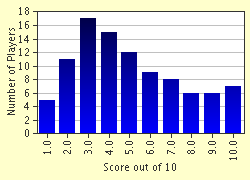Quiz Answer Key and Fun Facts
1. St Kilda is part of which group of islands?
2. St Kilda is known to have been inhabited since:
3. The most recent inhabitants of St Kilda came from:
4. St Kilda is most famous for the fact that Bonnie Prince Charlie used it as a refuge when fleeing Scotland in 1745, following the defeat of the Jacobite uprising.
5. Although St Kilda today has a diverse population of seabirds and other wildlife, what two species are known to be extinct on the island?
6. For many years the St Kildans were self-sufficient and lived off the land. What component made up a large portion of their diet?
7. Despite its long history of habitation, no-one lives on St Kilda today. What happened to the people who once lived there?
8. Before the last inhabitants disappeared from St. Kilda's, they sent out a plea for help. How did they do this?
9. What happened to St. Kilda after the last inhabitants left?
10. A recent discovery on St. Kilda has shed some light on the increasing problem of food shortage on the island in the later years of habitation. What was it?
Source: Author
fsk
This quiz was reviewed by FunTrivia editor
bloomsby before going online.
Any errors found in FunTrivia content are routinely corrected through our feedback system.


